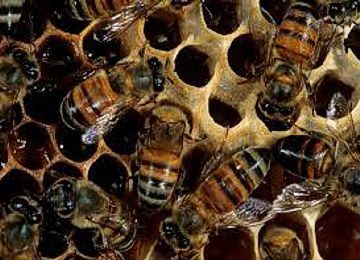Africanized Honey Bees in Tennessee

The USDA has a map detailing the spread of the Africanized honey bee over time by county in the US. The Tennessee Department of Agriculture and the University of Tennessee Extension are working together to prepare emergency personnel, pesticide applicators, beekeepers and the general public for the arrival of Africanized honey bees in Tennessee. If you believe you have found a colony of Africanized honey bees, get away from it as quickly as possible and contact the State Apiarist at 615-837-5342.
Africanized honey bees differ from European honey bees in behavior not appearance. Neither type of honey bee will indiscriminately attack humans or animals. The Hollywood image of “killer bees” is a dramatic exaggeration devised to sell movie tickets. Stinging is a defensive behavior employed by the colony to protect their brood (young bees) and food supply. Once a honey bee stings it dies. All bee colonies should be respected. Wild (feral) colonies should be avoided and reported to the county extension agent or the State Apiarist. Africanized honey bees will respond in much greater numbers than European honey bees to a perceived threat.
- AHB are more defensive than EHB.
- AHB defend a larger area than EHB.
- AHB are more easily disturbed and respond in greater numbers than EHB.
- AHB may swarm as often as every six weeks.
- EHB generally only swarm once a year.
- AHB will nest in any available cavity or in the open. Nest sites include: water meter boxes, metal utility poles, cement blocks, junk piles, and house eaves. Other potential nesting sites include overturned flower pots, old tires, mobile home skirts, and abandoned structures. Holes in the ground and tree limbs, mail boxes, even an empty soda pop could be viewed as "home" to the AHB.
- EHB nest in larger cavities above ground and sometimes in the open. EHB do not nest in holes in the ground. Nest sites include: a beekeeper’s hive, hollow trees, cavities in walls and occasionally in the open on a tree limb.
- AHB are more sensitive to vibrations than EHB, therefore care must be used when operating machinery near known AHB colonies.
- AHB will pursue a threat for over a mile where EHB will only pursue a threat for a few hundred yards.
- RUN away quickly. Do not stop to help others. However, small children and the disabled may need some assistance.
- As you are running, pull your shirt up over your head to protect your face, but make sure it does not slow your progress. This will help keep the bees from targeting the sensitive areas around your head and eyes.
- Continue to RUN. Do not stop running until you reach shelter, such as a vehicle or building. A few bees may follow you indoors. However, if you run to a well-lit area, the bees will tend to become confused and fly to windows. Do not jump into water! The bees will wait for you to come up for air. If you are trapped for some reason, cover up with blankets, sleeping bags, clothes, or whatever else is immediately available.
- Do not swat at the bees or flail your arms. Bees are attracted to movement and crushed bees emit a smell that will attract more bees.
- Once you have reached shelter or have outrun the bees, remove all stingers. When a honey bee stings, it leaves its stinger in the skin. This kills the honey bee so it can't sting again, but it also means that venom continues to enter into the wound for a short time.
- Do not pull stingers out with tweezers or your fingers. This will only squeeze more venom into the wound. Instead, scrape the stinger out sideways using your fingernail, the edge of a credit card, a dull knife blade or other straight-edged object.
- If you see someone being attacked by bees, encourage them to run away or seek shelter. Do not attempt to rescue them yourself. Call 911 to report a serious stinging attack. The emergency response personnel in your area have probably been trained to handle bee attacks. After calling 911 report the incident to the State Apiarist at 615-837-5342.
- If you have been stung more than 15 times, or are feeling ill, or if you have any reason to believe you may be allergic to bee stings, seek medical attention immediately. The average person can safely tolerate 10 stings per pound of body weight. This means that although 500 stings can kill a child, the average adult could withstand more than 1100 stings.